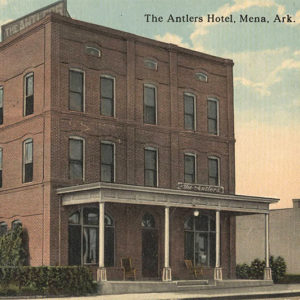By Dr. Curtis Varnell
Highway 71 south of Fort Smith passes through some of the more scenic regions of Arkansas, much of it through and over the forest of the Ouachita mountains. Mena, one of the more picturesque and vibrant towns along the route has an interesting and historical past. The original town consisted of just a few farms, located on a dirt road running from Fort Smith to Fort Towson in Indian territory. It remained that until Arthur Stillwell selected it as a central train station on the route from Kansas City to Port Arthur, Texas. These small towns, located as central points to drop off coal, railroad ties, and other building materials while building the next section of rail, were called “hell towns.” Villages, composed of tents and make-shift buildings, sprang up over-night, attracting more permanent merchants and businessmen who remained as the railroad moved on. In 1896, the town consisted of only some 300 or so of these railroad people, a year later the town had 3,185 inhabitants and a multitude of thriving businesses.



Like most small towns, Mena has had it’s share of good and bad events. On a least two occasions, the town has been hit and partially destroyed by tornadoes. It has suffered as businesses, including the railroad, have waxed and waned in importance. Historically, the two-events most outsiders have heard about are the Ebenezer affair and the Mena Airport debacle.
In late 1924, a group called the Commonwealth College began operations in Polk County. The group began as a cooperative colony in Louisiana and were either expelled or decided to seek the isolation of rural Arkansas. The stated purpose of the college was to educate students by allowing them to obtain an education while working in a commune type environment. The communal life did not sit well with the locals who saw it as a den of perversion, free love, and communism. The FBI was called in but charges were never filed. Local churches rallied in opposition to the group, eventually building a monument to demonstrate their opposition to the college. The college operated under continued attacks until 1940 when it was closed. The monument still stands and is listed as a national historic site.
The more recent event, and once most known to the general public, is the 1980’s involvement of Mena airport in Nicaragua/Contra affair. The affair, duped “Black Eagle” by CIA director William Casey, was a scheme to secretly supply weapons to groups fighting communism in Nicaragua. Bypassing legal governmental chains of command, the plan was to use private citizens to serve as conduits in shipping weapons. Several unscrupulous individuals were ready to assist. Berriman “Barry” Seal had been flying drugs into the U.S. for years and saw this as an opportunity to make even more money, and avoiding prosecution, by shipping weapons south for the CIA and delivering cocaine back to America. Moving his center of operations from Louisiana to Mena Municipal airport, he is said to have cornered the drug market in the Southwest. Berriman received $500,000 from the cartel for each load of cocaine delivered and had over 60 million dollars in his account when he was later gun-downed by the cartels. Much of Mena’s involvement is conjecture; in 1988 the White House blocked an investigation into the activities in Mena, but in 1996, the CIA acknowledged involvement in an operation at the airport. In 2017, the movie American Made starring Tom Cruise portrayed the events surrounding Mena and the drug cartels. It is interesting to note that Barry Seals personal jet was confiscated and is now on display at the Arkansas Air and Military Museum in Fayetteville.
Today, Mena is a small, peaceful, friendly town of about 6,000. Downtown is dotted by many antique shops, small cafes, parks, and the old railroad station. Known as the gateway to Wilhelmina State Park and Rich Mountain, it is becoming the center of off-road mountain biking in the state. With a great school, new businesses, and a growing industry, it is an outstanding place to live or visit.







